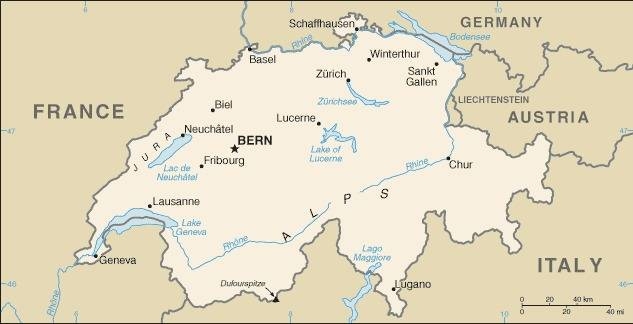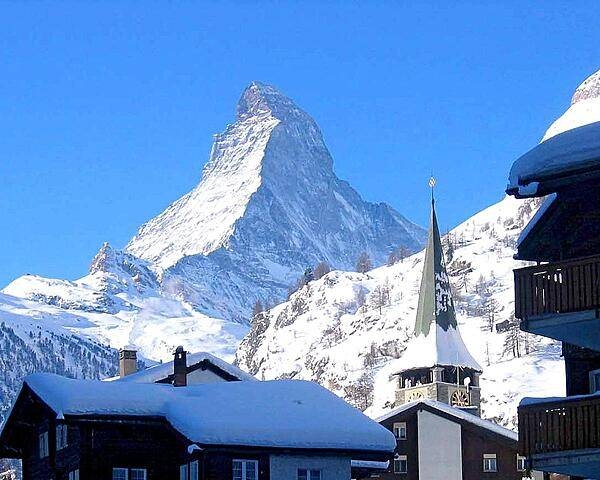112 Switzerland

Red square with a bold, equilateral white cross in the center that does not extend to the edges of the flag. Various medieval legends purport to describe the origin of the flag. A white cross used as identification for troops of the Swiss Confederation is first attested at the Battle of Laupen (1339).
Flag courtesy of the CIA World Factbook

Map courtesy of the CIA World Factbook

The Matterhorn towers over the roofs of Zermatt; at 4,478 m (14,688 ft), is one of the highest peaks in the Alps.
Photo courtesy of the CIA World Factbook
Government
According to Britannica, Switzerland’s constitution (modeled after that of the United States) was adopted in 1848 and substantially revised in 1874. A thoroughly revised constitution, approved by three-fifths of voters, entered into force in 2000, though the changes were mainly formal, with little alteration to the structure of Switzerland’s government. Because the old constitution had become unmethodical and difficult to understand, the new constitution coherently incorporated the multitude of amendments passed in the previous 125 years. Switzerland’s constitution contains some 200 articles, which establish the rights and duties of the citizens and of the governing bodies. It also created what has been termed a consociational democracy, which attempts to maintain political balance and stability, given the country’s linguistic and religious diversity.
The federal government supervises external and internal security, transportation affairs, forestry, and water conservation. It also is responsible for foreign policy and customs, the monetary system, the military, and social insurance programs. It has the authority to take steps to adjust the course of the economy and provide for uniform administration of justice in the areas of criminal and civil law.
Legislative power resides in the bicameral Federal Assembly, comprising the National Council, with 200 deputies elected by a system of proportional representation for four-year terms, and the Council of States, in which each canton is represented by two deputies and each demi-canton by one deputy (46 deputies in total). The executive branch is headed by the Federal Council, a seven-member collegial board. The presidency of the Federal Council rotates among the members annually, and each councillor presides over a federal department. The governments of other countries often have 20 or more ministers, and because of the Federal Council’s increasing workload (domestic responsibilities coupled with Switzerland’s burgeoning international commitments), there has been considerable debate about enlarging the Council or adding another level of ministers between the Federal Council and the Federal Assembly. However, Swiss voters, who would have to approve this restructuring, are fairly cautious about making such constitutional changes, especially those that might upset the very subtle balance between the different language groups.
One of the unique aspects of Switzerland’s constitution is the number of decisions it requires citizens to make through referenda and initiatives. Sovereign power ultimately rests with the people, who vote on proposed legislation several times a year at the national level and often more frequently in the cantons; indeed, Switzerland has held more than half of the world’s national referenda. For example, in 1971 the constitution was amended by national referendum to grant women the right to vote in federal elections and to hold federal office, in 1991 the voting age in federal elections was reduced from 20 to 18 years, and in 2002 voters endorsed entry into the United Nations (UN). Referenda must be held on constitutional matters and major international treaties; voters may also call a referendum to challenge a law passed by the Federal Assembly by obtaining 50,000 signatures within 100 days of passage. For a referendum to pass, it must receive an overall majority both of the national vote and in a majority of the cantons.
In addition to referenda, Swiss citizens can call a national vote on any issue by collecting 100,000 signatures. The first such initiative was undertaken in 1893, when voters decided against the wishes of the parliament and endorsed the prohibition of the killing of animals according to Jewish religious methods. More recently, voters have cast ballots on whether to join the European Economic Area (rejected), eliminate the Swiss army (rejected), reduce military spending (rejected), conserve moorland (approved), restrict immigration from the EU (approved), and adopt a universal basic income (rejected). The Swiss model has provided citizens with a direct voice in their own affairs that is without parallel in any other country, but it has sometimes been criticized on various grounds: voter turnout is often very low, averaging about two-fifths of the electorate; it often makes the passage of important legislation difficult (e.g., the parliament passed a law granting women the right to vote in 1959, but voters did not approve the change at the federal level until 12 years later); and it raises the prospect that the rights of minority groups can be undermined by a majority of the population, though Swiss voters in practice have generally respected the rights of minorities.
The Swiss Confederation is divided into 26 cantons (including six demicantons, or Halbkantone, which function as full cantons), each of which has its own constitution and assembly. The cantons exercise broad authority, possessing all powers not specifically given to the federal government. Education and health policies are largely determined at the cantonal level. While historically several cantons had a Landsgemeinde, only Appenzell Inner Rhoden and Glarus maintain this traditional assembly consisting of all the canton’s citizens that meets annually and serves as the canton’s primary decision-making body.
The Swiss Confederation consists of some 3,000 communes, which are responsible for public utilities and roads and, like the cantons, are largely autonomous. Communes range in size from Bagnes in Valais, with an area of 109 square miles (282 square km), to Ponte Tresa in Ticino, with an area of 0.1 square mile (0.3 square km). They also vary considerably in population; many have only several hundred residents, while the commune of Zürich has more than 350,000 residents. From the multiplicity of small communal republics stem a special quality to each and, paradoxically, a basis of national unity, for each citizen treasures and supports the freedom of the commune, a shared conviction that unites a citizen with the rest of the population in a way that transcends differences of language and of party. It is the communes rather than the country that grant Swiss citizenship.
The Swiss Civil Code of 1912 has furnished a model for the administration of justice in many countries; indeed, parts of the code have been adopted verbatim in other legal systems. The difficult task of creating and preserving a uniform judicial system within so diverse a national structure has produced a number of great jurists and experts of international law. Each canton elects and maintains its own magistracy for ordinary civil and criminal trials. Supreme judicial power is vested in the Federal Supreme Court (Bundesgericht), the seat of which is in Lausanne. Members of the court are elected by the Federal Assembly to six-year terms. Capital punishment was abolished, except under circumstances of martial law, general mobilization, or war—by the unified federal penal code of 1937.
Federal Office of Civil Aviation (FOCA)
As an independent regulator, the Federal Office of Civil Aviation (FOCA) is responsible for ensuring the highest safety and security standards in Swiss civil aviation. It takes measures to promote civil aviation and strives for its sustainable development. Through its activities, the FOCA contributes to Switzerland’s locational appeal. The FOCA participates in international aviation organizations so as to ensure that Switzerland’s national interests receive due consideration.
Airspace
SkyVector – Google Maps – ADS-B Exchange
ICAO countries publish an Aeronautical Information Publication (AIP). This document is divided into three parts: General (GEN), En Route (ENR) and Aerodromes (AD). ENR 1.4 details the types of airspace classes they chose to adopt from classes A through G.
Switzerland AIP (Fee required)
Drone Regulations
Advanced Air Mobility (AAM) Regulations & Policies
UAMAS – Urban Air Mobility Association Switzerland
Bilateral agreements facilitate the reciprocal airworthiness certification of civil aeronautical products imported/exported between two signatory countries. A Bilateral Airworthiness Agreement (BAA) or Bilateral Aviation Safety Agreement (BASA) with Implementation Procedures for Airworthiness (IPA) provides for airworthiness technical cooperation between the FAA and its counterpart civil aviation authorities.
Bilateral Aviation Safety Agreement – Executive Agreement
Implementation Procedures for Airworthiness
Implementation Procedures for Airworthiness – Amendment 1
2016 Notification of Policy Deviation Memorandum for FAA Order 8130.21H
Flight Standards Agreements
Maintenance Implementation Procedures (MIP)
Maintenance Agreement Guidance, Change 2
Implementation Procedures for Licensing (IPL)
Simulator Implementation Procedures (SIP) (Inactive)
Advanced Air Mobility (AAM) News
2025
Video courtesy of Advanced Air Mobility Institute from the July 2025 Global AAM Forum.
2025 – Urban-Air Port, SITA partner on vertiports
2025 – Volatus, Dufour Aerospace to partner on VTOL drone (VIDEO)
2025
Video courtesy of Advanced Air Mobility Institute from the January 2025 Global AAM Forum. Complete session for Day 1 of this Forum is available on the Advanced Air Mobility Institute YouTube Channel
2023 – Volocopter integrates Swiss-AS MRO software into its operations ecosystem
2023 – Lilium signs agreement with Air-Dynamic to serve Switzerland, Italy
2022 – Switzerland to adopt EU regulations relating to drones from January 2023
Short Essay Questions
Scenario-Based Question
You have been hired by a Drone Startup Company. Your boss has immediately assigned this job to you.
They need you to prepare a one-page memo detailing the legalities of using a drone to film the Matterhorn towers in the Alps, pictured above.
They need you to mention any national laws and local ordinances.
They specifically want to know what airspace (insert pictures) you will be operating in and whether or not you need an airspace authorization.
Does it matter whether or not you are a citizen of the country?
Lastly, there is a bonus for you if, as you scroll through this chapter, you find any typos or broken links!
Short Essay Questions
- What are the drone categories?
- How is registration addressed?
- How is remote ID addressed?
- What are the model aircraft rules?
- What are the commercial drone rules?
- Are there waivers or exemptions to the rules? If so, for what?
- Would you share a link to an interactive airspace map?
- How is BVLOS addressed?
- How can you fly drones at night?
- How can you fly drones over people?
- Where do you find drone NOTAMs?
- What are the rules for drone maintenance?
- What are the rules for an SMS program?
- What are some unique rules not mentioned above?
- What are the C-UAS rules?
- What are the AAM rules?

